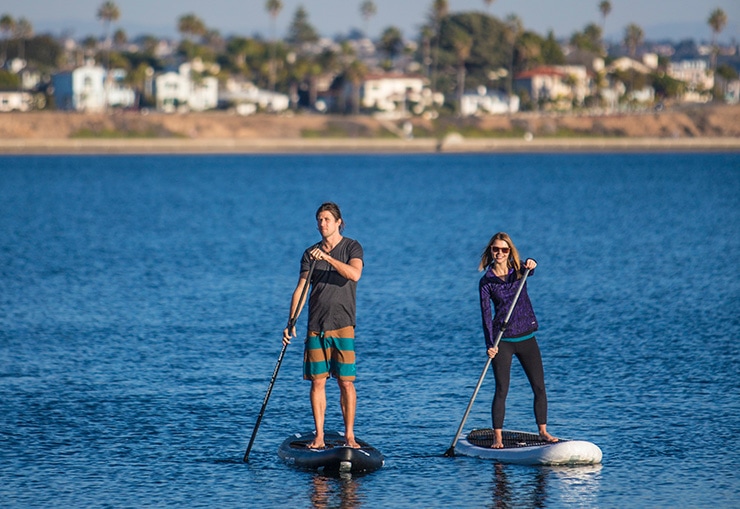One person may look at a paddler out in the water and think, “well, that’s easy.” Another one may consider the idea of standing on a small flat vessel on water intimidating.
If you’ve been toying with the idea of getting into SUP, you may be wondering about the learning curve. Or the degree of difficulty.
It helps to know whether you’ll master paddle boarding in the first few sessions. Or whether you should prepare yourself for a frustrating learning experience.
So is paddle boarding hard?
The answer is no. Stand up paddle boarding is not hard, in fact it’s actually pretty easy to learn the basics and anybody can do it.
Let’s get into the details.
How Hard Is Stand up Paddle Boarding?
SUP boarding is not hard at all–it’s an incredibly easy water sport. It’s not difficult to learn or do, regardless of your age and fitness level. The basic paddle boarding skills are quite simple and you can master them in a few sessions.
Learning to stay balanced while standing on a paddle board is what some people may find challenging. But as long as you choose a SUP board that’s right for your size and skill level, you’ll be alright.
Beginner paddle boards are usually wide and moderately long, giving you a bigger and more stable surface to paddle on. So with a good beginner board, you won’t find it hard to stay balanced.
It also helps to be armed with a few paddle boarding tips. If you have an idea of where to stand on the SUP, where to look, and how to make a proper paddle stroke, you’re already halfway there.
Why is SUP One of The Easiest Water Sports?
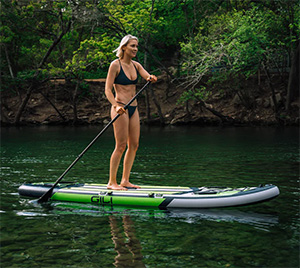
One thing that makes SUP boarding so easy is the fact that it’s a gentle sport that anyone can do, regardless of age, size, and fitness level. All you need is a SUP paddle board, basic SUP essentials (like a paddle and a leash), and a body of water to paddle on.
There’s also no one way to paddle board. You can vary your SUP paddling sessions to make them easier or more difficult. This means it can be as easy as you want it to be.
For instance, if you’re having issues with balance while in the standing position, you can choose to kneel instead. Even better, you can attach a kayak seat to your SUP and paddle while seated.
If you’re not confident in your paddling skills or you feel that you’re lacking in strength or stamina, you can paddle in calm, shallow water.
Another thing that makes SUP easy is that there are different boards for different skill levels. With a wide beginner paddle board, you’ll find the most challenging part of SUP–balancing–much easier.
ALSO READ: Which is harder: paddle boarding or kayaking?
How Hard is Paddle Boarding for Kids?
Even for kids, paddle boarding isn’t hard.
There are SUP boards designed specifically for young paddle boarders. They are smaller so kids don’t strain to make a proper paddle stroke and control the board. Children can practice paddling in a fun and easy way until they’re ready older.
Besides, you can also make paddle boarding easier for your kids by tandem paddling with them. Get your little paddler their own paddle and have them paddle with you.
This way, they can learn SUP without having to do much of the work.
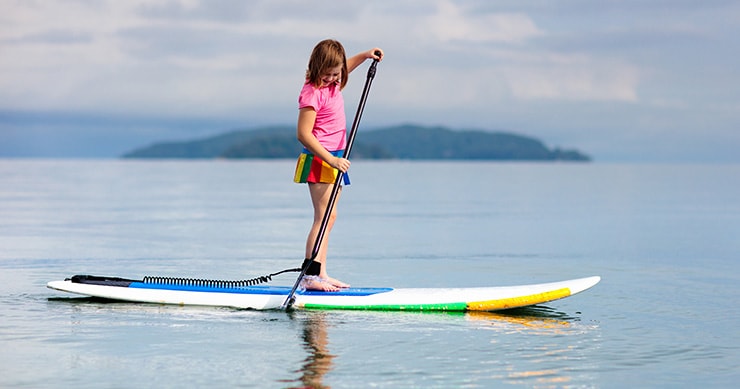
Is Paddle Boarding Difficult for Seniors?
No, paddle boarding isn’t difficult for seniors as it’s a low-impact workout. It’s gentle on bones, joints, and ligaments. There is a very low chance of spraining something or getting hurt while SUPing–it’s not like running. You could actually describe SUP as being a somewhat gentle form of exercise.
Plus, as mentioned, you can make paddle boarding easier to suit your needs (or more challenging if you prefer). If you aren’t very strong you can get a good paddle board seat. This will allow you to alternate between sitting and standing.
It’s a nice gentle exercise that engages almost every muscle in your body without straining you.
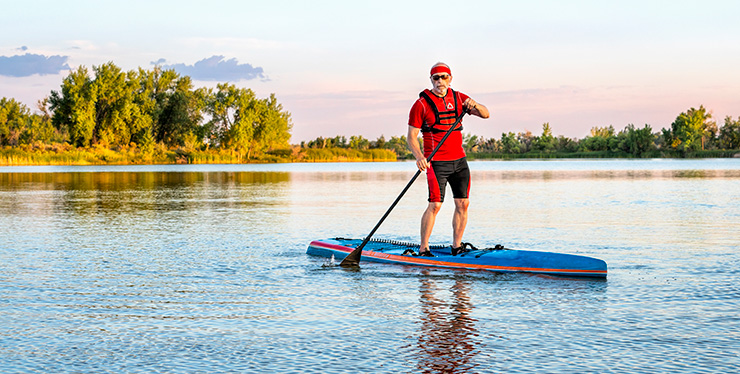
How Exhausting is Paddle Boarding?
There’s a slight difference between something being hard to learn vs hard to do. Paddle boarding is easy enough to learn the basics – but how hard is it to paddle your board? How strenuous is paddle boarding to do?
This will depend on a few factors such as your fitness level, where you’re paddling, and the type of SUP activity.
Although stand up paddle boarding is easy to learn, it’s a full-body workout that requires effort. If you haven’t been active for a while, you may find it more exhausting than someone who has been working out. But it will get easier if you do it regularly.
It can also be exhausting depending on where you’ll be paddling. A paddler on a calm lake will have an easier time compared to one paddling the ocean on a windy day. Or a whitewater paddler running rivers.
Some SUP activities are also more exhausting than others. For instance, paddle board racing or SUP surfing is more exhausting than paddling leisurely on flat water. So you can choose a more or less taxing SUP activity depending on what you’re comfortable with.
Is Paddle Boarding Hard on Your Back?
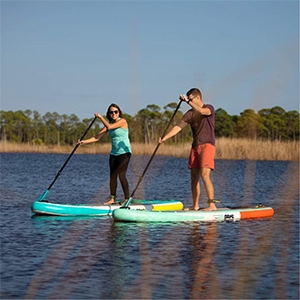
Back pain is a common issue–one that nobody likes to deal with. So it’s only right to worry about the effect of SUP on your back.
Stand up paddle boarding is not hard on your back. It can actually be good for people with back pain. It strengthens your back and core muscles, something that can help prevent back problems.
However, SUP can be hard on your back if you don’t do it properly. There are bad paddling habits that will make your back pain worse. Or cause you to start having back issues. These include arching your back or flexing your spine.
You’re supposed to keep your back straight and relaxed, even when you twist your torso.
Is Paddle Boarding Hard on Your Knees?
No, stand up paddle boarding is not hard on your knees. As mentioned above, it’s a low-impact exercise that won’t strain your joints or ligaments.
In fact, it is sometimes recommended for people with bad knees or even knee injuries. SUP is a fantastic rehabilitation sport because it’s gentle. With time, it will rehabilitate and strengthen your knees and leg muscles, making them better.
If you have a knee problem, it’s best to talk to your doctor first so they can clear you for paddling. Also start with calm water and keep each SUP session short. Observe how you feel and then you can make the sessions longer and more intense with time.
How to Learn Paddle Boarding Basics Easily
One thing that will make paddle boarding easier for you is learning the basics. Luckily, they’re simple. Here is a very basic rundown of the essential starting-points of SUP:
Make Sure You’re Using the Right SUP and Gear
There are four key items that you’ll need for paddle boarding:
- The right board
- A well-sized paddle
- A personal flotation device
- A leash
Fortunately, most SUP boards, and especially inflatable paddle boards, come with all these essentials in the package.
You need a paddle board that’s right for your height, weight, and skill level. For beginners and paddlers who are on the bigger side, a wider board is more suited for extra stability. So look for a SUP that’s at least 32 inches wide.
The paddle size and blade size is important too. Bigger blades make a more powerful stroke but they also require more effort than smaller blades, so if you want to keep your paddline session from becoming too strenuous, keep this in mind.
But don’t worry. If you’re a newbie you’ll be fine with the paddle that comes with your SUP board.
Begin in a Kneeling Position
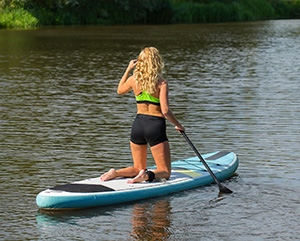
After you launch your SUP, it’s better to stand by paddling while in a kneeling position. This makes paddle boarding easier because your center of gravity will be lower, resulting in more stability.
It also allows you to get familiar with being on a SUP on water and the paddling movement.
While standing on the side of your board, hold it on either side. Climb onto the SUP, with your knees on either side of the center carry handle.
Shift from Kneeling to Standing
Start practicing how to stand once you feel comfortable on the paddle board. It can take a couple of tries for you to finally get it so don’t be discouraged.
Hold your paddle board on either side for stability, then quickly stand with your feet shoulder-width apart and on either side of the center grab handle. Stand paddling immediately.
Remember you don’t have to stand if you don’t feel ready. This is the beauty of SUP–you can still have fun while doing what you feel is right for you. Even while kneeling you’ll still be getting an incredible workout.
Learn How to Balance On Your Paddle Board
Balancing on a paddle board can be a little tricky for some people. But there are a few things you can do to make it easier.
First, stand with your knees slightly bent and make sure you’re standing at the center of the board. Don’t lean too much on either side because the SUP will wobble.
Another thing, don’t stare at the paddle board, your feet, or the paddle. Look straight ahead. Find something fixed on the horizon and fix your eyes on that.
Learn How to Paddle Correctly
A proper paddle stroke will give your stroke more power, ensure you get a good full-body workout, and prevent you from getting injured.
Start your paddle stroke by reaching as far forward–close to the nose of the SUP–as you can. Plant the paddle blade fully into the water. As soon as the blade reaches your feet, slice it out of the water.
Keep your arms straight and slightly twist your torso as you make your stroke.
Remember to alternate strokes. After every few paddling strokes switch and paddle on the other side of the board to keep it going straight.
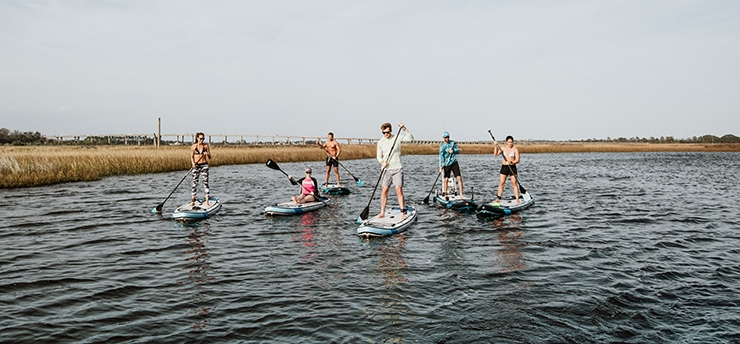
More Tips to Make Paddle Boarding Easy
The best way to make paddle boarding easy is to start by taking SUP lessons. A professional will help you adopt the right form and paddling strokes so you don’t pick up bad habits that you’ll find hard to drop.
SUP is now quite popular and you can find instructors near you.
Another way to make SUP boarding easier is to find paddling buddies. This could be a family member who’s a paddler, or a friend.
Paddling buddies will make learning easier and safer for you. It’s also fun to paddle with friends.
You may also want to start with calm, sheltered waters while learning. A location like that will be more forgiving, allowing you to learn the basics comfortably.
Lastly, focus on having fun and you’ll find it easy. Don’t overthink anything–as long as you’ve taken all the necessary safety precautions you’ll be having. Enjoy the entire process, even the falling, and you’ll see that SUP isn’t difficult at all.
So is Paddle Boarding Easy?
Yes, stand up paddle boarding is easy.
SUP is a low-impact activity that anyone can do; including seniors, kids, and people with injuries. (If you have an injury consult your doctor first). It’s gentle on your back, knees, joints, and entire body–provided you do it correctly.
Paddle boarding is also easily accessible and you can do it anywhere. All you need is a board, paddle, leash, life jacket, and a body of water.
The best thing about SUP boarding is that you can make it as easy as you like. If you’re having a hard time standing, you can sit or kneel. For added stability, you can get a wider SUP and paddle on flat water where the board won’t sway too much.
If you’ve been thinking about taking up SUP, don’t hesitate. It’s easy –and it’s fun!

